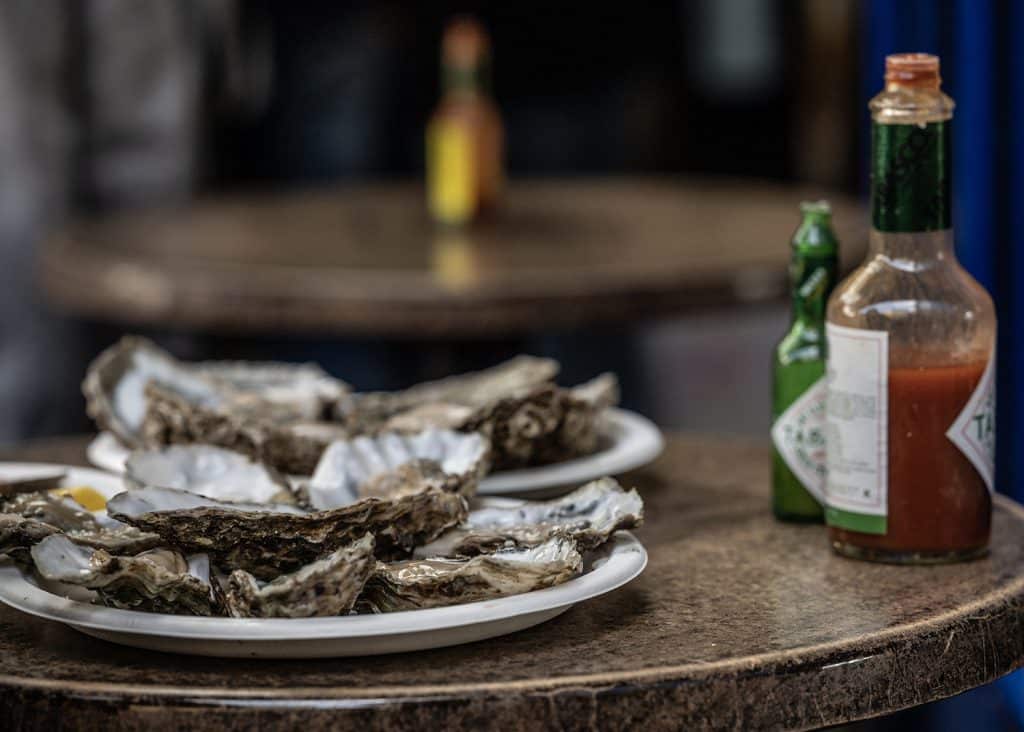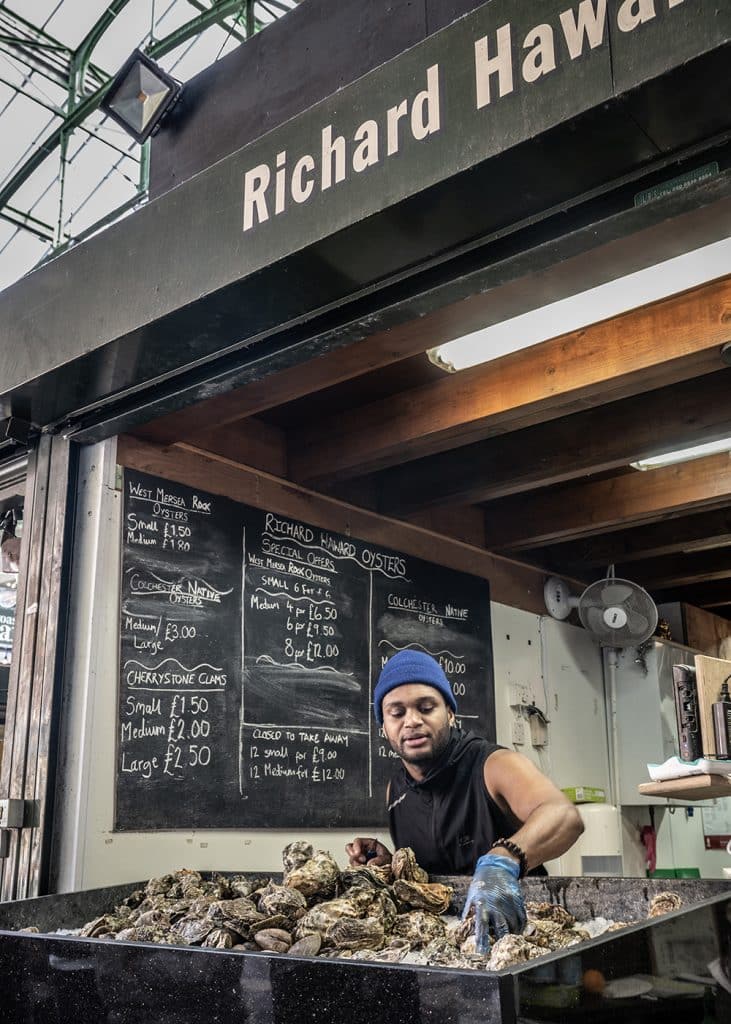The quality of Mersea
Tom Haward of Richard Haward’s Oysters on cultivating oysters on Mersea Island, the difference between natives and rocks, and why interest in these briny bivalves is starting to soar


“OYSTERS ARE LIKE WINE – THEY TASTE OF THEIR ENVIRONMENT. OURS TASTE LIKE THEY’VE BEEN AGED IN THE MARSHES”
Words: Tomé Morrissy-Swan
At Richard Haward’s Oysters in Borough Market, Tom Haward is guiding me through a selection of briny bivalves. There are three sizes: small, medium and large. I’m instructed to eat the small one with lemon, the next two with shallot vinegar. Each one is delicious – and remarkably different. The small oyster is sweet, the medium creamy with hints of vanilla.
The largest is intensely salty, and certainly needs the oniony vinegar to cut through the salinity. “It’s a much older oyster, so it’s been absorbing the salt for a few more years,” Tom explains. It’s eight years old and has filtered 100 litres of water a day for its whole life. “That’s a lot of salt,” says Tom. It’s an eye-opening introduction to the world of oysters.
The Richard Haward’s Oysters stand is a market stalwart. Here, they sell 2,500 oysters a day (plus a few clams) to locals, shoppers, tourists and a significant number of social media influencers, who opt for the giant ones. “They absolutely love them, but it’s too much even for me,” says Tom, as we sip on a dark ale from Mersea. Along with stout, it’s one of the best pairings for the salty oysters.

The Haward family have farmed oysters on Mersea Island on the Blackwater estuary in Essex since at least 1769. “We think it goes back further,” says Tom, who took over the business last year when his father, the legendary Richard Haward, passed away. Tom, at least the eighth generation to oyster farmers to work on the same stretch of water, explains that the Romans discovered a rich source of oysters on Mersea, shipping them across their empire. By the 1700s, the Hawards were helping fuel huge demand in London. Oysters were once so quotidian that you can still see their shells tossed on the shores of the Thames. One contemporary report estimated that 124 million were sold at Billingsgate Market in 1851. “There were millions of oysters a year going into London out of Mersea, and there are still millions a year now,” says Tom proudly.
Not much has changed, though the oysters are now driven to London rather than sailed. Tom still sends them to Billingsgate and local food sellers around the city, but half go through Borough Market. The growing method is similar, too. There are 15 acres of oyster beds with very low-intervention farming: the seeds are sown in certain areas and left to grow until ready to harvest. The beds are rotated, to allow them to flourish, like a farmer rotating his crops. “My dad used to hate it when people said it was farming. ‘Oh no, we cultivate,’ he’d say. I’m not so precious about that term, though, because we do farm in many ways.”
While embracing the idea of being a farmer, Tom also describes the company’s oysters as ‘wild’. Most oysters, he explains, are hatched in labs and, once they hit a certain size, put in bags, cages or trestles and grown on in the water. The Hawards’ oysters, by contrast, are gathered from wild areas around the British coast – areas where the nutrients aren’t as optimal – and moved to Mersea, where the shallow tidal creeks bring in from the marshes the nutrient-dense water, filled with phytoplankton. “That’s plumping the oyster up and giving it that unique flavour,” he says.
Tom believes Mersea is the only place where this system of wild farming happens in the UK. “There’s a crossover between cultivating and farming. We’re letting mother nature do what she does best. We’re just giving her a helping hand. If I went back in time and saw what my great-great-grandfather was doing, I think he’d be doing it pretty similarly to how we’re doing it now.”
But there is one key difference between today’s oysters and those of Tom’s ancestors. Due to overfishing, pollution, disease and the introduction of invasive species, there has been a 95 per cent drop in native oyster populations around the UK and Ireland since the mid-19th century, according to the Native Oyster Network. There have been several attempts to reintroduce them in the wild, including 10,000 released last year on a man-made reef off the northeast coast. The oysters Tom serves me today are rocks, also known as Pacific oysters, a species introduced from abroad in the 1960s to keep the industry going. Natives, Tom explains, are “basically extinct, and I don’t think we’ll ever see the stocks of native oysters come back.” The water, he continues, is now too warm, and they haven’t evolved to acclimatise.

Natives represent just one per cent of the business (and two per cent of oysters sold overall in the UK) and are also sold at The Company Shed, the family’s restaurant on Mersea Island. Unlike rock oysters, which are available all year round, they’re only available from September to April, and are left alone the rest of the year to allow stock levels to recover. “We do it because it’s part of our heritage and tradition, but there just aren’t the stocks there. I only want to do a small amount, because we need to leave them alone, and give them a chance to maybe find a way to replenish.”
Native oysters have a distinctive flat, round shell – think of Botticelli’s The Birth of Venus – and are creamier and less briney, as they don’t filter as much water, thus absorbing less salt. Rock oysters have a sweeter flavour with a brinier finish. Some swear by natives and deride rocks. “That comes from many years ago, when rocks were an inferior product in this country, but personally I prefer rocks over natives,” says Tom.
Yet even within rock oysters there are considerable variations. The shores off Mersea are muddy, it’s one of the saltiest stretches of water in the country, and nutrients wash in from the surrounding marshland. The saltiness makes them among the briniest in the country, and the nutrients provide a deeper flavour and longer finish. “Oysters are like wine – they taste of the environment they grow in,” Tom explains. “Our oysters taste like they’ve been aged in the marshes; there’s a different depth of flavour.”
Back in the 1980s, oysters were considered a “yuppie thing”, says Tom. Now that’s firmly changed. Oyster stalls can be found at most markets, holidaymakers in seaside towns post pictures of their half-dozens, and there’s barely a restaurant that doesn’t feature them as a starter. At Borough Market, they’re among the most accessible snacks. For Tom, there are multiple reasons why we’ve fallen in love again. They’re environmentally friendly, helping filter the water, and can create complex reefs that provide habitat for juvenile fish, crabs, sea snails and sponges. Around the water beds on Mersea, the water is “so clear”, says Tom. Even some vegans eat oysters, due to their environmental benefits and the fact that, like mussels, they’re not sentient beings.
“There’s been a real awakening that oysters are fantastic products,” says Tom. “There’s a younger generation who are really passionate about food, about trying stuff that isn’t mass-produced rubbish. Some of it is down to the quality of the product. Not just us, but around the UK, there are passionate oyster producers who are trying to prove this is a wonderful thing to eat, and we should be proud of it in the UK.”